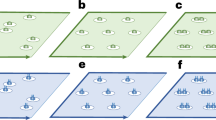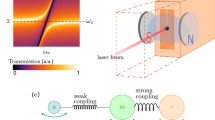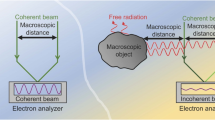Abstract
It is occasionally possible to interpret strongly interacting many-body systems within a single-particle framework by introducing suitable fictitious entities, or ‘quasi-particles’. A notable recent example of the successful application of such an approach is for a two-dimensional electron system that is exposed to a strong perpendicular magnetic field. The conduction properties of the system are governed by electron–electron interactions, which cause the fractional quantum Hall effect1. Composite fermions, electrons that are dressed with magnetic flux quanta pointing opposite to the applied magnetic field, were identified as apposite quasi-particles that simplify our understanding of the fractional quantum Hall effect2,3. They precess, like electrons, along circular cyclotron orbits, but with a diameter determined by a reduced effective magnetic field4,5,6,7,8,9,10. The frequency of their cyclotron motion has hitherto remained enigmatic, as the effective mass is no longer related to the band mass of the original electrons and is entirely generated from electron–electron interactions. Here we demonstrate enhanced absorption of a microwave field in the composite fermion regime, and interpret it as a resonance with the frequency of their circular motion. From this inferred cyclotron resonance, we derive a composite fermion effective mass that varies from 0.7 to 1.2 times that of the electron mass in vacuum as their density is tuned from 0.6 × 1011 cm-2 to 1.2 × 1011 cm-2.
This is a preview of subscription content, access via your institution
Access options
Subscribe to this journal
Receive 51 print issues and online access
$199.00 per year
only $3.90 per issue
Buy this article
- Purchase on Springer Link
- Instant access to full article PDF
Prices may be subject to local taxes which are calculated during checkout




Similar content being viewed by others
References
Das Sarma, S. & Pinczuk, A. (eds) Perspectives on Quantum Hall Effects (Wiley, New York, 1996).
Jain, J. K. The composite fermion: a quantum particle and its quantum fluids. Physics Today 53 (4), 39–45 (2000).
Jain, J. K. Composite fermion approach for the fractional quantum Hall effect. Phys. Rev. Lett. 63, 199–202 (1989).
Halperin, B. I., Lee, P. A. & Read, N. Theory of the half-filled Landau level. Phys. Rev. B 47, 7312–7343 (1993).
Heinomen, O. (ed.) Composite Fermions (World Scientific, Singapore, 1998).
Du, R. R., Stormer, H. L., Tsui, D. C., Pfeiffer, L. N. & West, K. W. Experimental evidence for new particles in the fractional quantum Hall effect. Phys. Rev. Lett. 70, 2944–2947 (1993).
Du, R. R. et al. Fractional quantum Hall effect around ν = 3/2: composite fermions with a spin. Phys. Rev. Lett. 75, 3926–3929 (1995).
Willett, R. L., Ruel, R. R., West, K. W. & Pfeiffer, L. N. Experimental demonstration of a Fermi surface at one-half filling of the lowest Landau level. Phys. Rev. Lett. 71, 3846–3849 (1993).
Goldman, V. J., Su, B. & Jain, J. K. Detection of composite fermions by magnetic focusing. Phys. Rev. Lett. 72, 2065–2068 (1994).
Smet, J. H., Weiss, D., Blick, R. H., Lütjering, G. & von Klitzing, K. Magnetic focusing of composite fermions through arrays of cavities. Phys. Rev. Lett. 77, 2272–2275 (1996).
Kohn, W. Cyclotron resonance and de Haas-van Alphen oscillations of an interacting electron gas. Phys. Rev. 123, 1242–1244 (1961).
Gubarev, S. I. et al. Screening of excitonic states by low-density 2D charge carriers in GaAs/AlGaAs quantum wells. JETP Lett. 72, 324–328 (2000).
Allen, S. J., Stömer, H. L. & Hwang, J. C. M. Dimensional resonance of the two-dimensional electron gas in selectively doped GaAs/AlGaAs heterostructures. Phys. Rev. 28, 4875–4877 (1983).
Gerhardts, R. R., Weiss, D. & von Klitzing, K. Novel magnetoresistance oscillations in a periodically modulated two-dimensional electron gas. Phys. Rev. Lett. 62, 1173–1176 (1989).
Shilton, J. M. et al. Effect of spatial dispersion on acoustoelectric current in a high mobility two-dimensional electron gas. Phys. Rev. B 51, 14770–14773 (1995).
Jain, J. K. & Kamilla, R. K. in Composite Fermions (ed. Heinonen, O.) 1–80 (World Scientific, Singapore, 1998).
Park, K. & Jain, J. K. Phase diagram of the spin polarization of composite fermions and a new effective mass. Phys. Rev. Lett. 80, 4237–4240 (1998).
Du, R. R., Stormer, H. L., Tsui, D. C., Pfeiffer, L. N. & West, K. W. Phys. Rev. Lett. 70, 2944–2947 (1993).
Willett, R. L. in Composite Fermions (ed. Heinonen, O.) 349–431 (World Scientific, Singapore, 1998).
Acknowledgements
We acknowledge the Volkswagen Stiftung, the Russian Fund of Fundamental Research, INTAS, the German Ministry of Science and Education and the German Physical Society for their support.
Author information
Authors and Affiliations
Corresponding author
Ethics declarations
Competing interests
The authors declare no competing financial interests.
Rights and permissions
About this article
Cite this article
Kukushkin, I., Smet, J., von Klitzing, K. et al. Cyclotron resonance of composite fermions. Nature 415, 409–412 (2002). https://doi.org/10.1038/415409a
Received:
Accepted:
Issue Date:
DOI: https://doi.org/10.1038/415409a
This article is cited by
-
Coherent cyclotron motion beyond Kohn’s theorem
Nature Physics (2016)
-
A note contrasting two microscopic theories of the fractional quantum Hall effect
Indian Journal of Physics (2014)
-
Optical probing of composite fermions in a two-dimensional electron gas
Nature Physics (2006)
Comments
By submitting a comment you agree to abide by our Terms and Community Guidelines. If you find something abusive or that does not comply with our terms or guidelines please flag it as inappropriate.



